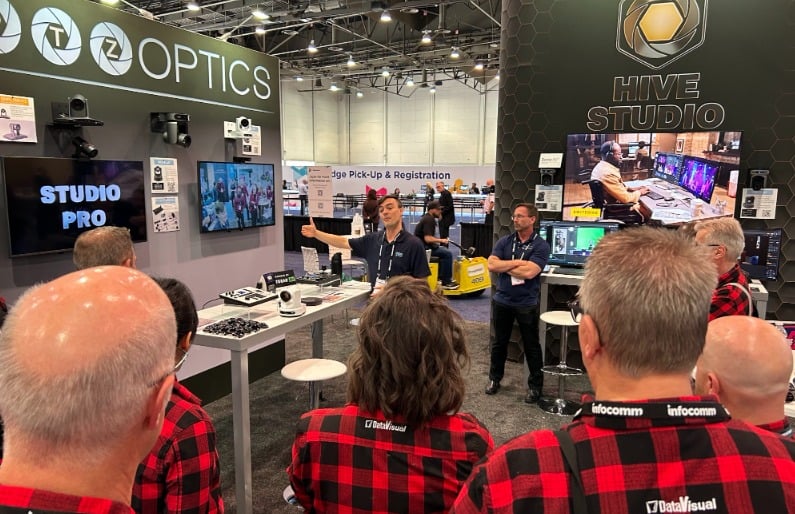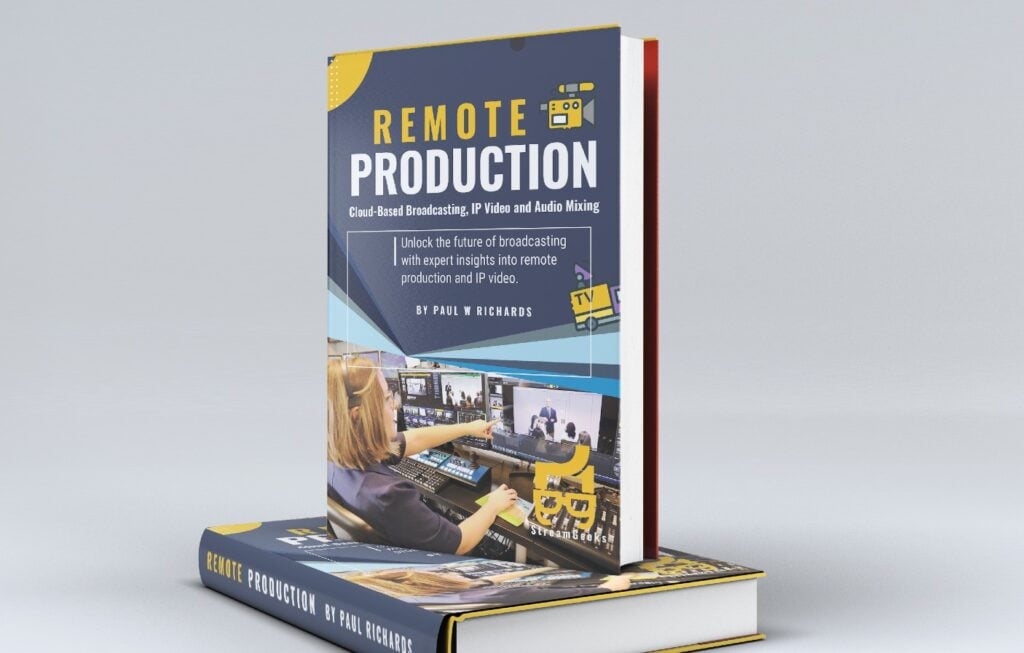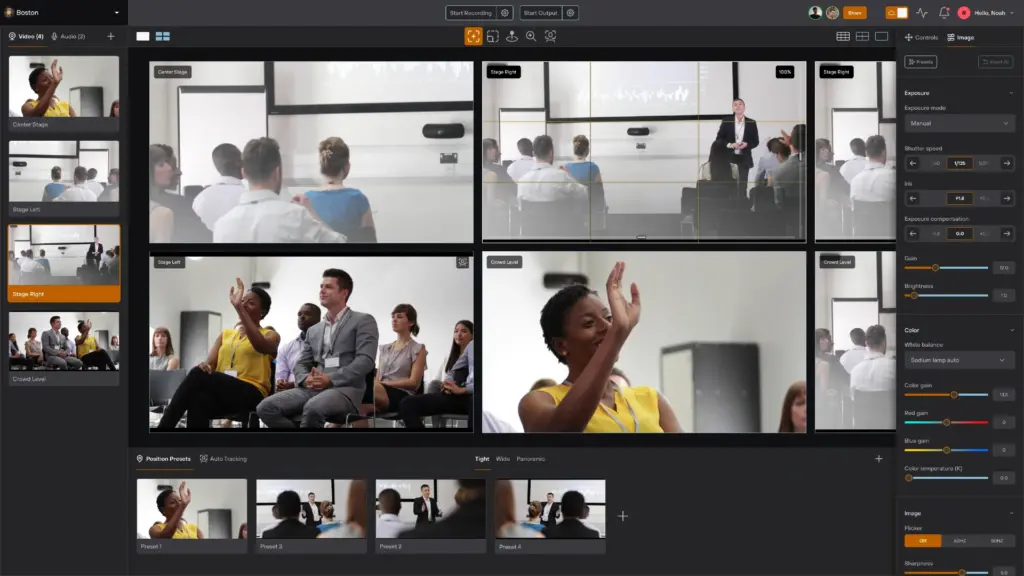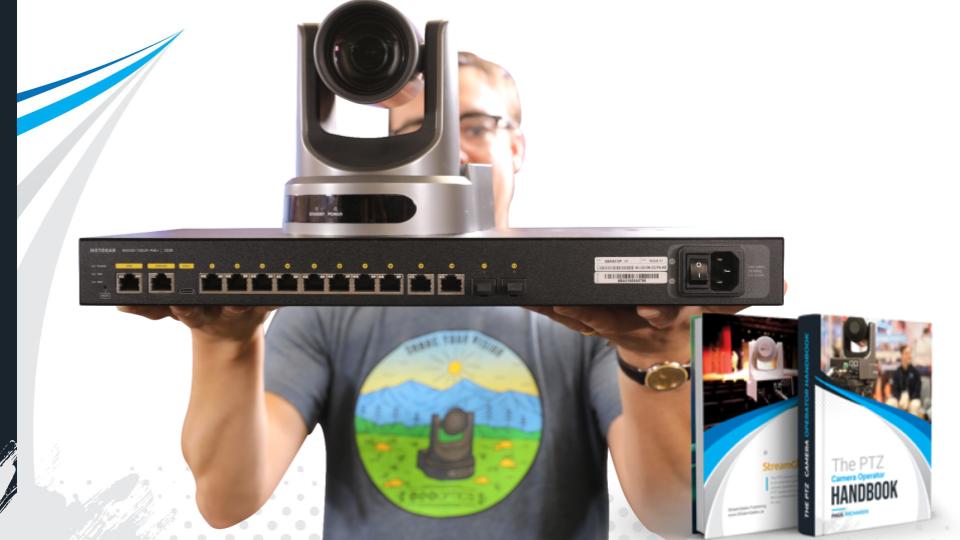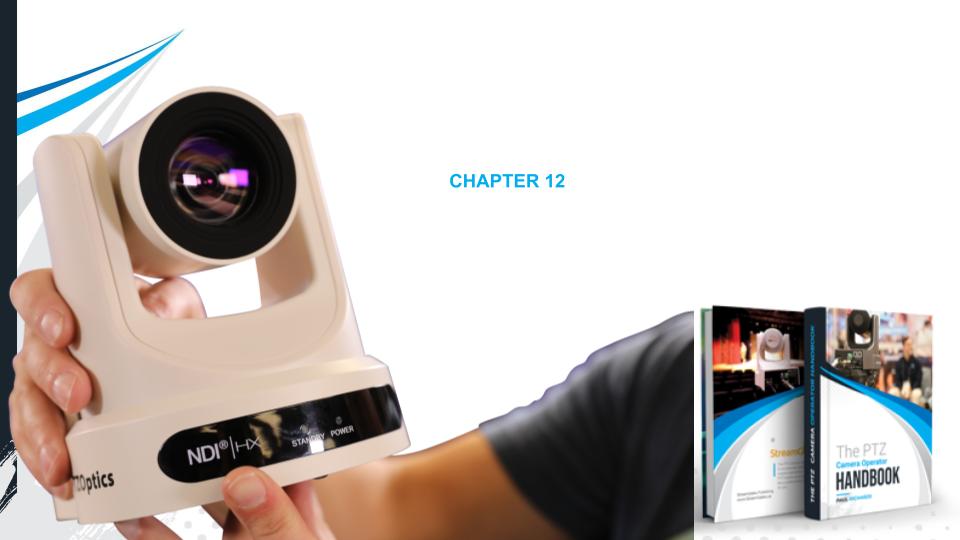Automating PTZ Camera Controls
Written by Paul Richards on November 29, 2021
Robots were meant to be controlled by humans. Robotic cameras are no different. With the latest advancements in PTZ camera technology, you can effectively automate many PTZ camera movements with no need for manual camera control.
Automated PTZ Camera Controls
There are a variety of ways to trigger a PTZ preset to go off automatically when your production calls for it. For example, using open broadcaster software (OBS) you can add a web browser input to any scene that sends an HTTP command to move to a specific preset any time the producer switches to a specific input. You can enter multiple HTTP commands into OBS using multiple browser sources in the same scene to control, for example, one or two cameras simultaneously. The reason you would do this is to automate your production workflow. If you want the camera to go to a specific position at the end of a show, you can literally hard-code the commands into your video production software so that the PTZ preset move command is sent as soon as you transition to that specific scene.
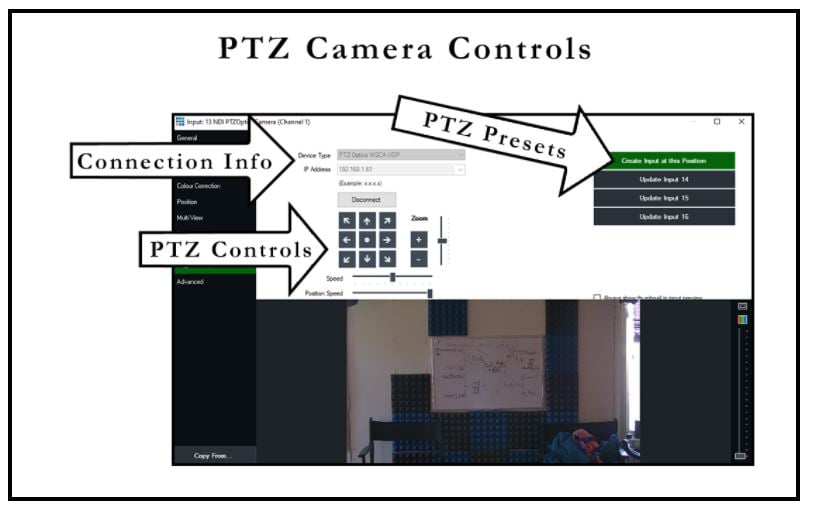
Automated PTZ Camera Controls shown in vMix
Another use case for PTZ camera automation occurs during pre-show segments. For example, you can set up a loop of PTZ camera presets using OBS, Wirecast, vMix, or any of the other live streaming software that supports PTZ controls and playlists. In vMix, for example, each time you create a PTZ preset, the software creates an input for that PTZ preset position. Using vMix’s playlist feature you can set up the software to loop through an automated list of PTZ camera movements. This allows the software to issue the PTZ camera commands in a loop so that the cameras keep moving during a pre-or post-show segment.
Using OBS, the popular livestreaming software, for example, you can trigger multiple PTZ cameras to move using HTTP triggers at the same time. A list of these HTTP commands can usually be found at your PTZ camera manufacturer’s website. Many forward-thinking PTZ camera operators have found ways to automate PTZ camera movements and effectively move multiple PTZ cameras at the same time exactly when they are needed. Controlling multiple cameras at the same time used to take a crew of camera operators. Today there are a variety of ways to control multiple robotic PTZ cameras with the single click of a button. Controlling multiple PTZ cameras at the same time is ideal for “scene changes” where you would like some, or all of your PTZ cameras to move to a new location at the same time.
Why should you automate the control of multiple PTZ cameras at the same time?
Increasingly, video producers are also becoming camera operators. With the advent of remotely controlled PTZ cameras, a single video production person can also operate PTZ cameras with relative ease. In many scenarios, video producers are operating two or three PTZ cameras at the same time using video production software like OBS, Wirecast, vMix, Livestream Studio, or the Tricaster. Many video production software solutions have integrated PTZ camera controls which allow the software on a Mac or PC computer to connect to PTZ cameras over a local area network.
In most cases today, video production software operators are able to quickly take control of a robotic camera and move the camera’s position directly through the livestreaming software they are already using. This is ideal during a live production because a production operator can simply make a few clicks, zoom in on a camera, check the focus, and then transition to the camera. This takes the video to live without an on-site camera operator to perform the task on-demand.
Another popular way to control multiple PTZ cameras is to have a hardware joystick for the video production operator to use. Hardware joysticks are popular because a team of two can split up the tasks between live video switching and camera operation. Whether you are using hardware or software for PTZ camera controls, it’s nice to be able to move multiple PTZ cameras at the same time with the click of a button.
How to control multiple PTZ cameras in OBS at the same time
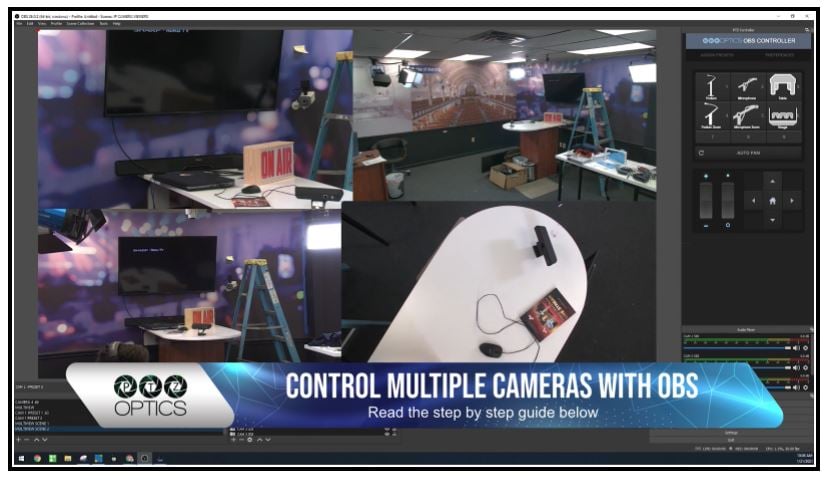
Example PTZ controls in OBS
Using OBS you can control PTZ cameras in a couple of different ways. The most popular way is to install the free PTZOptics OBS plugin which adds some great robotic camera control features to OBS. Once installed, you can open up the plugin and control up to 8 cameras. The plugin even creates specific hotkeys for calling PTZ presets and it adds the ability to control cameras with a USB-connected Xbox joystick. Another way to control PTZ cameras is to use what OBS calls a “Dockable” interface. You can use the HTML code available from PTZOptics to place a PTZ controller directly into the OBS interface. The HTML files can be used with the “Docks” feature of OBS to dock a PTZ camera controller directly into the OBS interface.
A third way to control PTZ cameras with OBS involves using HTTP commands. A document reviewing all of the HTTP commands for your PTZ camera is generally found on the manufacturer’s website. These commands can be entered into OBS using the “Browser Source” input and are used to call a PTZ camera preset. In this way, you can enter multiple HTTP commands into OBS using multiple browser sources in the same scene to control various cameras.
Using OBS to control multiple cameras at the same time involves a scene that is set up with multiple browser sources and HTTP commands. Remember to select “Refresh when active” to ensure OBS issues the HTTP commands every time that you select the scene in OBS.
Pro Tip: You can issue additional HTTP commands besides camera presets. Check out the complete list of HTTP commands in the PTZOptics documentation to learn more.
How to control multiple PTZ cameras with vMix
You can control multiple PTZ cameras with vMix using the Pro or 4K versions of the software. In order to take control of PTZ cameras inside of vMix, you need to know the IP address of your PTZ cameras and be on the same local area network as the cameras. If you do not know the IP address of your cameras, consult the instructions in the manual. Once you know the IP address, enter it into vMix to gain control over your PTZ cameras.
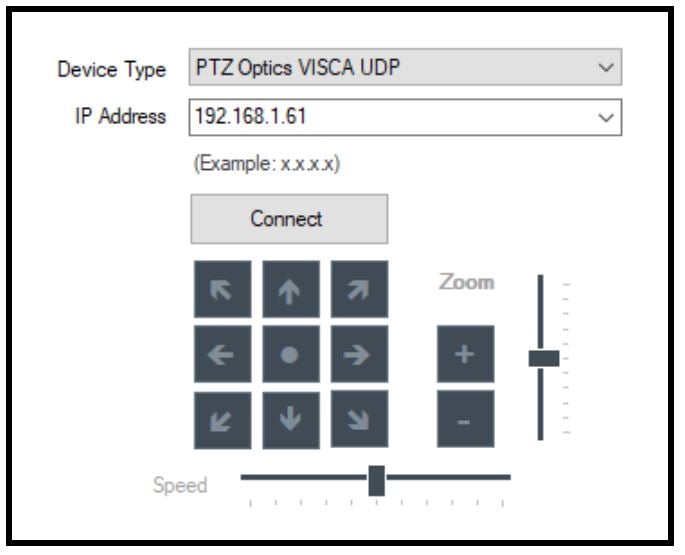
PTZ Control Interface in vMix
Select PTZOptics as the camera type, enter the IP address and click connect. You can use the pan, tilt, and zoom controls to start moving your camera around the room. As you are controlling the camera, notice the speed options available for manual pan/tilt and preset pan/tilt. These are the controls you can use to tell vMix the speed at which you want the camera to move in a manual setting and during presets.
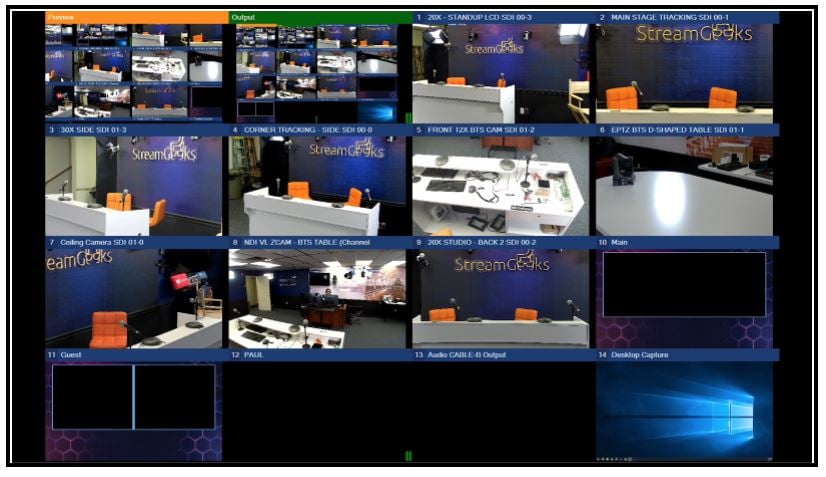
Using the vMix Multiview
In order to control multiple PTZ camera movements with vMix, start by creating PTZ presets. Once connected to a PTZ camera with vMix, you can create presets inside of vMix using the “Create Input at this Position” button. When you click this button, vMix will create an input with a thumbnail image of the camera’s current location. When you bring this input into the vMix Preview window, vMix will recall that PTZ preset and move the camera. In this way, you can move your PTZOptics camera around your space and create multiple PTZ presets. Each preset receives a PTZ input inside of vMix for easy recall.
You can repeat the process above with each PTZ camera that you want to use. Once finished, organize the PTZ cameras you want to move with a single click. From here, you can use the vMix Multi-View feature available in the input settings of any input. Choose the input that you would like to use to trigger all the PTZ cameras. You can then add each PTZ camera input to the Multi-View as you build a single input with multiple inputs attached. Uncheck each PTZ input so the PTZ positions will be recalled, but not overlaid on top of each other. Once completed, you can transition to this vMix input and call multiple presets at once.
Pro Tip: If you are using multiple PTZ cameras with vMix, use a high-quality graphics card. For example, if you have an NVIDIA graphics card, add vMix as a default application to the “NVIDIA Control Panel.” Double-check in the vMix settings that the graphics card is enabled.
How to control multiple PTZ cameras at once with a joystick
The PTZOptics SuperJoy is a joystick controller with a feature called the “SuperPreset” which allows you to use a custom button to control multiple PTZ cameras at once. The PTZOptics SuperJoy features four custom buttons that you can set up to do all sorts of video-related tasks. For example, you can set up a custom SuperJoy button to turn on IP-connected lighting in a studio setting. You can control pretty much anything that accepts TCP/UDP, or HTTP commands. Luckily, PTZOptics cameras have been designed to work with this joystick and the engineers have set up the “SuperPreset” to control up to 6 cameras at once.
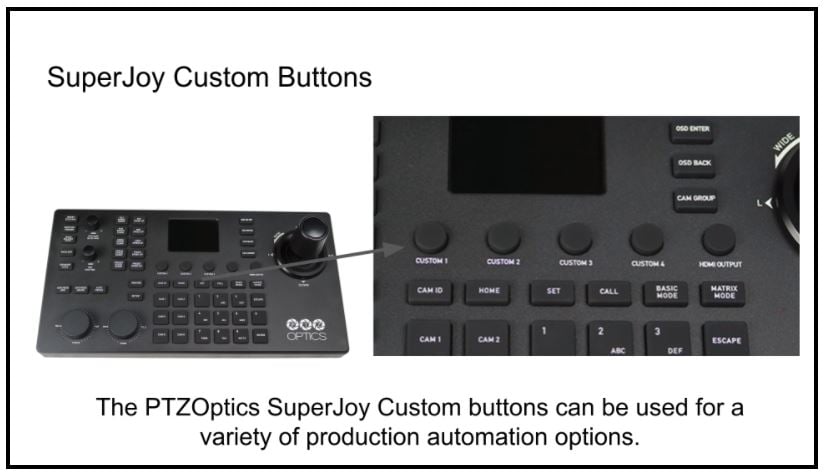
PTZOptics SuperJoy Custom Buttons
To get started, connect your PTZOptics SuperJoy to the network. You will need to connect your joystick to the cameras you wish to control. The SuperJoy is able to control PTZ cameras using serial or IP connections. The easiest way to connect your joystick to cameras is through the IP interface. You can reach this interface by entering the IP address shown on the device screen into any web browser. This will bring up the joystick interface which you can use to configure the unit. The first thing to do is make sure that all of your PTZ cameras are connected properly. Next, you can navigate to the “custom” tab which allows you to configure the four custom buttons on the joystick.
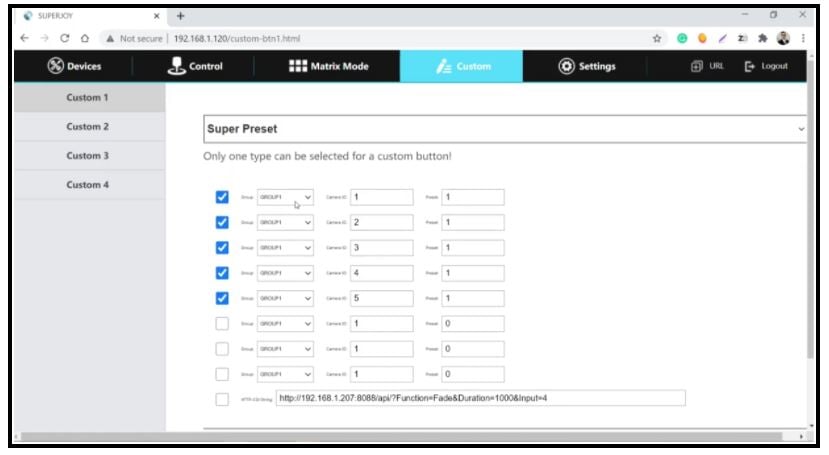
Using the SuperJoy Web Interface
These custom buttons can be set up to issue HTTP, TCP, and UDP commands over your network. There is also an option to choose “SuperPreset” which allows you to issue multiple PTZOptics cameras preset commands at once, plus an additional HTTP command. For a seamless scene change, move multiple PTZ cameras and issue an HTTP command to software like OBS or vMix to change scenes with a single command. Going down the SuperPreset list you can select multiple cameras and choose the order in which the joystick will issue the commands. At the end, you can also choose an HTTP command.
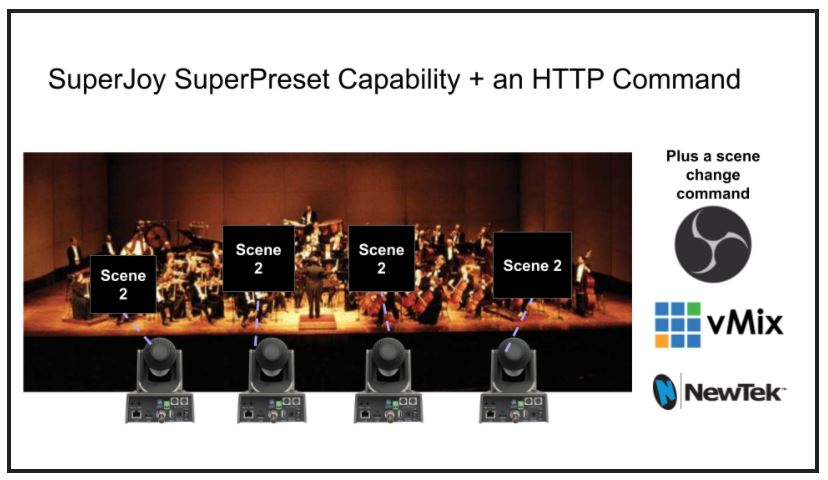
Example of a SuperPreset used with four cameras and a video production software such as OBS, vMix, or the NewTek Tricaster.
You now know quite a few ways to control multiple PTZ cameras with a single button. This will help you manage fast-paced video productions with small teams. Controlling multiple PTZ cameras at once during production can make life easier for operators. My advice is to think about where you want your PTZ cameras during a given livestream. Map out the PTZ preset positions and when you would like cameras to move, then correlate them to additional cameras. Once you have mapped out where you want your cameras to move and when to create simple one-click buttons to do so. This will make scene changes in your livestreams much easier to manage.
Key Takeaways:
- PTZ cameras can be controlled with many software and hardware solutions.
- Automating PTZ camera movements can be done by triggering PTZ preset movements on scene changes and other video production workflow items such as hotkeys and shortcuts.
- Automating the control of multiple PTZ cameras can be used to switch scenes with a single button during a video production.
Learn more about PTZ Cameras
- See how PTZ cameras are transforming video production here
- Learn high level, what a PTZ camera really is here
- Learn about every essential part of a PTZ camera here
- Learn about who is using PTZ cameras here
- Learn about the different types of PTZ cameras here
- Learn how to use an IR remote control with your PTZ cameras here
- Learn about the various PTZ camera control options here
- Learn how to mount a PTZ camera here
- Learn how to set the exposure of your PTZ camera here
- Learn about PTZ camera operation best practices here
- Learn about all the latest PTZ camera features here
- Learn how to automate PTZ camera controls here
- Learn more about Networking PTZ cameras here
- Learn about the new ePTZ camera technology here
- Learn about how innovations in video production are changing the industry here
- Learn how to use PTZ cameras for remote production here
